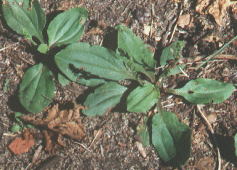|
|
 |

Common Plantain came to the United States with the Europeans. The native Americans, observing its spread, named it "white man's footprint" or "Englishman's foot". Perhaps they saw the same resemblance to feet (or affinity for paths) as the Greeks. "Plantago" is derived from a Latin word meaning "sole of the foot". Plantain is now naturalized throughout the United States. This is a perennial plant, which dies to the ground each winter and sprouts anew from its fibrous taproot around mid-spring. The oval, ribbed, short-stemmed leaves form basal rosettes which tend to hug the ground. The leaves may grow up to about 6" long and 4" wide. Between early summer and late fall, leafless flower stalks, 6" to 18" tall, arise from the center of the rosette. The flower stalks bear densely packed greenish white flowers each of which will become a small capsule-like seedpod containing 10 to 20 seeds. When the seeds are mature, the seedpods split in half, and the seeds fall to the ground to start the whole thing over. |

I commonly find plantain in gardens and lawns, along trails, in sidewalk cracks, and in similar habitats. It prefers full sun, but will grow in partial shade. It also prefers rich moist soil, but it will grow even in poor, fairly dry soils. Plantain is edible. The very young leaves can be added to salads, or cooked as greens. The leaves do become stringy and strongly flavored rather quickly as they age, particularly where they grow in hot, dry, or very sunny locations. This does not mean they are no longer edible, only that at this point, they are better suited to making stock or tea. Plantain is very high in beta carotene (A) and calcium. It also provides ascorbic acid (C). The immature flower stalks may be eaten raw or cooked. The seeds are said to have a nutty flavor and may be parched and added to a variety of foods or ground into flour. |

Among the more notable chemicals found in plantain are allantion, apigenin, aucubin, baicalein, linoleic acid, oleanolic acid, sorbitol, and tannin. Medicinally, plantain is astringent, demulcent, emollient, cooling, vulnerary, expectorant, antimicrobial, antiviral, antitoxin, and diuretic. It effects blood sugar, usually lowering it. It has been used to treat lung disorders and stomach problems. For these purposes, a tea is made from either the leaves or the whole plant and taken internally. This same tea may be used as a mouthwash to treat sores in the mouth and toothaches. It may also be used externally to treat sores, blisters, insect bites and stings, hemorrhoids, burns, rashes, and other skin irritations. Alternatively, a poultice of the leaves may be applied to the afflicted area. This is probably plantain's most common use. For relief from a bee sting or insect bite, simply shred (or chew) a plantain leaf and hold it on the bite for a few minutes. I've begun making a plantain ointment which is proving to be remarkably effective. Reports so far (and personal experience) indicate that it very rapidly relieves itching and swelling from bee stings, insect bites, poison ivy rash, and other allergic rashes. It also seems to speed healing of sores and bruises. The best part is that not only does this ointment work as well as or better than the usual commercial preparations, it's also completely non-toxic. I should add that plantain is currently being marketed as a stop smoking aid. The claim is that it causes an aversion to tobacco. I suppose the simple version of this would be to chew on a plantain leaf whenever you want to smoke. Doing this will freshen your breath, at least, and who knows, maybe you won't want that cigarette so much. Plantain seeds are very high in mucilage and fiber, among other things. The seeds of a closely related species (P. psyllium) are the primary ingredient in laxatives such as Metamucil. Common plantain seeds may be used in the same fashion. The plant provides food for butterfly caterpillars, rabbits, deer, and grouse. A wide variety of birds eat the seeds. To control or eradicate plantain, pull up the plants before they go to seed, or cover them with a thick layer of mulch. The best long-term control for plantain in a lawn is probably to shade it out, which can be done simply by setting your lawnmower a bit higher. *** Buy Plantain Ointment online! *** Selected References
|
|
| Home | About this site | Asides/Glossary | Store |
| Taxonomy Tree | Species list | Article list | |
|
Featured sponsors:
|
Mountain Rose Herbs Bulk herbs, teas, oils, & much more! |
Richter's Herbs Seeds & plants |
|
|
© 1999-2015 by Deb Schwartz. All rights reserved. Please send feedback to: deb@kingdomplantae.net Website by ki-yi.com
|
|||